 I blame Nutnfancy. Or maybe Call Of Duty: Modern Warfare. Either way, I’ve had a jones to pimp out a rifle with a Duracoat camo job for a while now, and my Century AK-74 seemed like a the perfect volunteer for my experiment. It’s a cheap rifle with a plain-jane black finish, and if I somehow managed to make it uglier I could always just paint it black again. Why camouflage? For the hell of it. Why Duracoat? Because Krylon is useless on guns, and I’m not enough of a gunsmith to attempt using more exotic (and expensive) bake-on gun finishes . . .
I blame Nutnfancy. Or maybe Call Of Duty: Modern Warfare. Either way, I’ve had a jones to pimp out a rifle with a Duracoat camo job for a while now, and my Century AK-74 seemed like a the perfect volunteer for my experiment. It’s a cheap rifle with a plain-jane black finish, and if I somehow managed to make it uglier I could always just paint it black again. Why camouflage? For the hell of it. Why Duracoat? Because Krylon is useless on guns, and I’m not enough of a gunsmith to attempt using more exotic (and expensive) bake-on gun finishes . . .
Lauer Custom Weaponry is the developer and manufacturer of the Duracoat line of gun finishes. They’re not as lustrous as the charcoal blueing on a pre-war Colt revolver, or as high-tech as a fancy nickel-boron AR bolt, but Duracoat finishes are resistant to corrosion and scratches, and they’re designed to be applied by home hobbyists using simple equipment.
They don’t need to be applied or cured at high temperatures, and this is important for the bubba gunsmith home hobbyist because few odors will disrupt your domestic tranquility (or persuade you never to cook at home again) faster than the industrial aroma of hot metal bluing in your kitchen oven.
How detailed is the Duracoat process, and how attractive/durable is the end result? Read on and follow my Duracoat odyssey.
The Kit
 The Duracoat EasyWay camo kit ($99) includes everything you see here: four 2-oz. bottles of Duracoat for the colors of the camo pattern in dark green, light grayish-green, and tan. The kit also includes hardener to mix with the Duracoat, a Preval spray bottle with a can of propellant, and a few dozen self-adhesive camo pattern stencils. For surface prep you get a bottle of degreaser and a small Scotch-Brite scrubbing pad, and there’s a bottle of reducer for clearing out the spray bottle between coats.
The Duracoat EasyWay camo kit ($99) includes everything you see here: four 2-oz. bottles of Duracoat for the colors of the camo pattern in dark green, light grayish-green, and tan. The kit also includes hardener to mix with the Duracoat, a Preval spray bottle with a can of propellant, and a few dozen self-adhesive camo pattern stencils. For surface prep you get a bottle of degreaser and a small Scotch-Brite scrubbing pad, and there’s a bottle of reducer for clearing out the spray bottle between coats.
I was worried that the small-looking propellant can wouldn’t be enough to shoot multiple coats over my AK-74, but it got the job done and then some. In addition to painting the whole rifle more than four times over, I also gave an old Remington Model 700 stock one coat of dark green, and I estimate I’ve still got enough paint and propellant on hand to Duracoat my AR-15’s stock furniture dark green if I get the urge. Which I think I will.
And they may not look like much, but these little bottles of paint go a long way. Lauer states that one kit will pimp out two pistols or one rifle, but I’m pretty sure I could do a full camo job on one rifle and two pistols, or even two rifles if I was careful. YMMV.
Preparation
All my research and homework told me that careful preparation is the key to a good Duracoat application. I took my AK apart until all I had was a receiver/barrel assembly and a pile of parts, although I decided to leave the trigger group in place. I carefully de-greased everything I wanted to paint by hosing it down with de-greaser, scrubbing it with the Scotch-Brite pad, and repeating the process. Polished or blued surfaces will take Duracoat better if they’re sandblasted, but the AK’s rough metal finish didn’t need any extra texturing.
My gunsmith gave me a few pointers before I started, and he recommended soaking the whole gun in acetone for twelve hours to get all the oil from the nooks and crannies of the receiver and trunnion. Since I don’t have a chemical stripping tank or several liters of acetone, this wasn’t an option for me. I hoped this wasn’t a crucial mistake.
I used blue painter’s tape to mask off the threaded muzzle, rear sight ladder, trigger, and the interior of the receiver. I also masked off the bottom of the receiver where the serial number is etched, because a thick coating might fill in and obliterate the rather faint engraving.
Here’s a video recap of my preparation process:
It was a lot of work to get even this far, but it was really only beginning.
Application
Spraying Duracoat onto the gun was fairly simple. After shaking the 2-oz. bottle of Duracoat for three full minutes, the instructions tell you to mix it with 1/4 of the bottle of hardener and shake for fifteen seconds. Then you screw on the Preval sprayer and let ‘er rip.
Shaking the little bottle for a full three minutes was not something I wanted to put on film; I’m sure you’re already seen the ‘Shake-Weight’ commercials, so I don’t really need to hotlink to them, do I?
I used a Sharpie to draw some hash marks on the side of the hardener bottle, to help me pour out exactly 1/4 of the bottle each time. This turned out to be extremely helpful, and I think Lauer might want to include a graduated bottle with future kits.
I’m a pretty clumsy hand with a paint sprayer, but I did manage to avoid gooping up the gun with dripping globs of Duracoat. Here’s what the project looked like after I’d shot two coats of what I thought was the base color, dark green.
I screwed up here because dark green isn’t the proper base coat for digital ACU camouflage, but as I may have mentioned I’m not artistically inclined. The package directions didn’t tell me which color to apply first, and even my internet research didn’t set me straight. Lauer includes a video with more instructions on it, but none of our computers could load the mini DVD.
The collective wisdom of the Internet did provide other useful tips however, including the advice to mount all the parts on coat hangers. This let me shoot them and hang them to dry without actually touching them, and it worked out extremely well since I only ended up with one single spot where the coat hanger scraped off the paint.
I waited five minutes between coats as the instructions recommend. They also say that you can handle coated surfaces twenty minutes after spraying, but I didn’t want fingerprints in the Duracoat (or permanently green fingertips) so I let the coated parts sit at least an hour before I touched the coated surfaces.
Stenciling
The EasyWay camo kit comes with a few dozen sheets of precisely cut digital-patterned adhesive stencils. I applied some of the ‘male’ stencils (small patterns which you paint around and over) which result in the entire gun being painted the color of the new coat, but with ‘islands’ of base color underneath.
After this video, I added a layer (two coats) of tan using the ‘female’ stencils, solid masking sheets with camo-shaped holes cut in them. These added a second semi-random layer of shapes over the base coat and first pattern layer.
Then I added a final layer of dark green again, using more of the smaller female stencils. This also required a half-roll of blue painter’s tape for masking over all the surfaces I didn’t want to overspray with tan. The smaller female stencils only used 1/2 of the tan bottle, since I thought I’d applied enough of that color, and 1/2 of the second bottle of dark green.
Results
I let the Duracoat dry overnight and pulled off several layers of masking tape and stencils, with the results we see below.
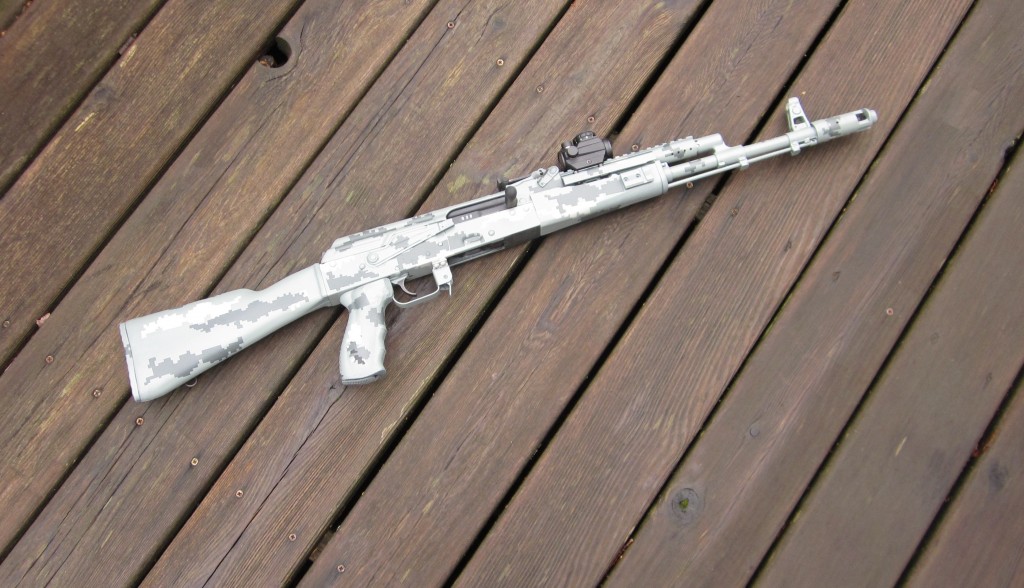
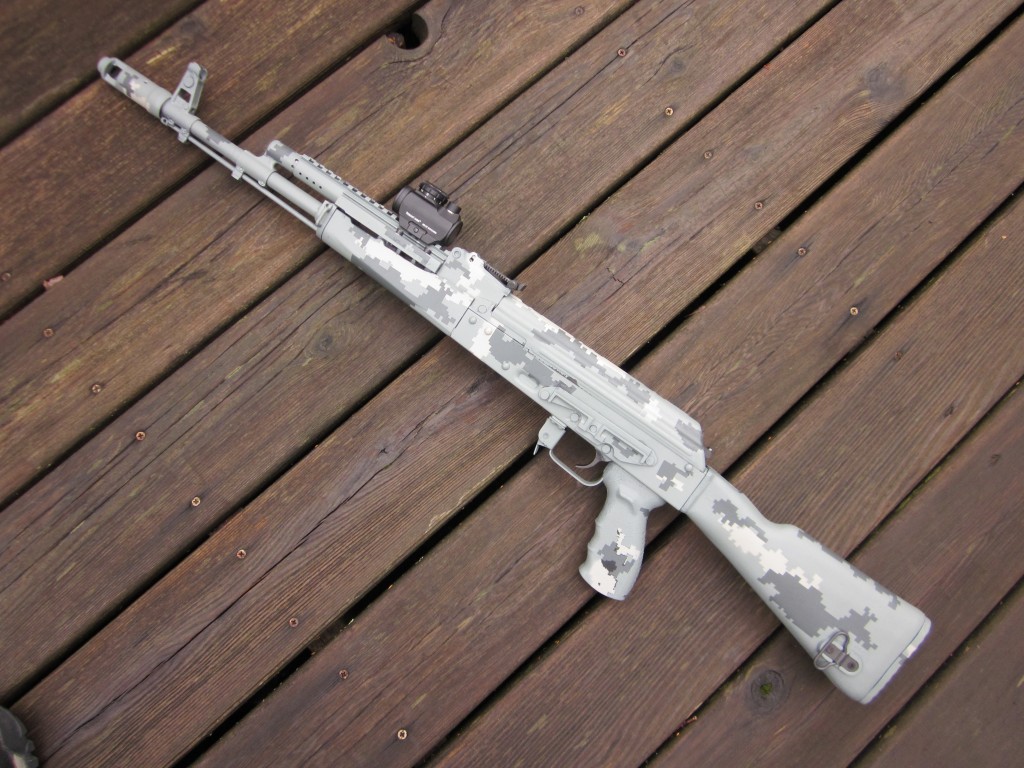 From these results, I can see that I made a few technical mistakes and numerous artistic ones. I had a few spots on the grips and dust cover where the male stencils pulled off the base coat and masked off all the other layers leaving bare metal (or rubber.)
From these results, I can see that I made a few technical mistakes and numerous artistic ones. I had a few spots on the grips and dust cover where the male stencils pulled off the base coat and masked off all the other layers leaving bare metal (or rubber.)
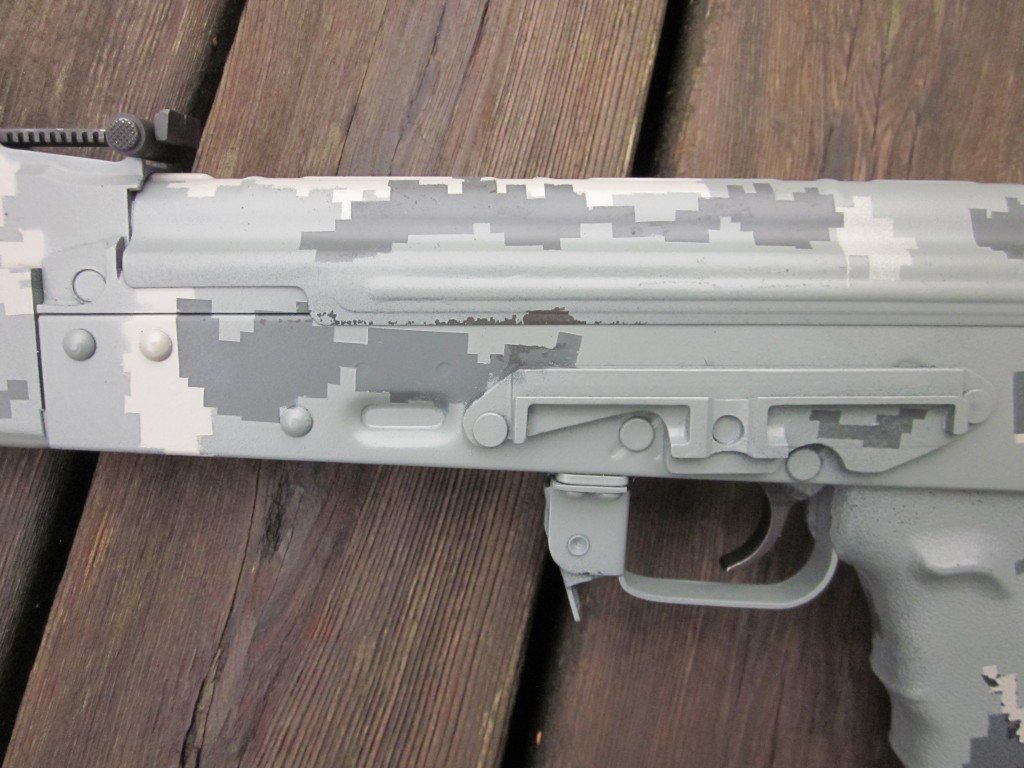
 I also found a couple of small bare spots on the sides of the magazine release, where my surface prep must have been inadequate and the Duracoat pulled away with the painter’s tape. All these places are pretty small and they don’t look too bad, but I’m going to shoot another coat over mag release and dust cover spots when I’m Duracoating the stock furniture on my AR with the leftovers. I’m not going to mess with the grip, since the Duracoat didn’t really like to stick to it anyway.
I also found a couple of small bare spots on the sides of the magazine release, where my surface prep must have been inadequate and the Duracoat pulled away with the painter’s tape. All these places are pretty small and they don’t look too bad, but I’m going to shoot another coat over mag release and dust cover spots when I’m Duracoating the stock furniture on my AR with the leftovers. I’m not going to mess with the grip, since the Duracoat didn’t really like to stick to it anyway.
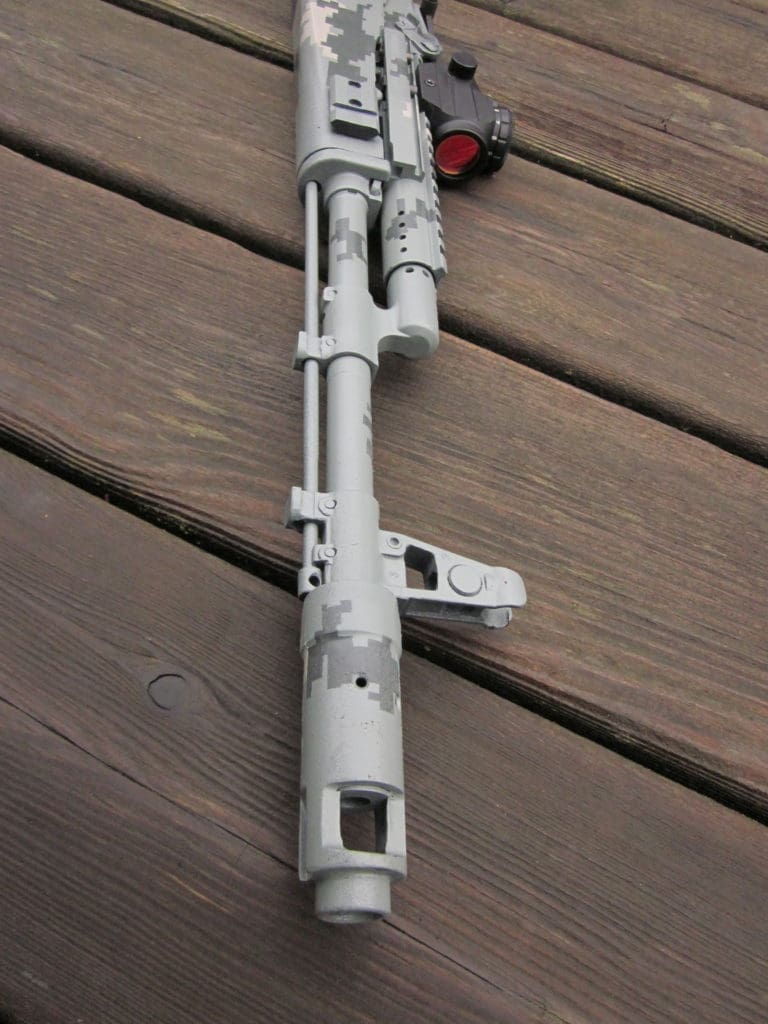 I probably should have used Duracoat-H to spray the barrel, muzzle device and gas tube. Regular-strength Duracoat has some temperature resistance, but above 500 degrees F it bakes and darkens. Shotguns, handguns and bolt-action rifles never approach this temperature, but prolonged rapid semi-auto fire can get even hotter. I don’t think I’ve ever done enough bump-firing to heat my AK up this badly, but I’ll be bummed if it happens. Duracoat-H will handle temperatures up to something like 1800F, but it’s not sold in camo kits.
I probably should have used Duracoat-H to spray the barrel, muzzle device and gas tube. Regular-strength Duracoat has some temperature resistance, but above 500 degrees F it bakes and darkens. Shotguns, handguns and bolt-action rifles never approach this temperature, but prolonged rapid semi-auto fire can get even hotter. I don’t think I’ve ever done enough bump-firing to heat my AK up this badly, but I’ll be bummed if it happens. Duracoat-H will handle temperatures up to something like 1800F, but it’s not sold in camo kits.
As I mentioned, I also committed a litany of artistic/aesthetic blunders. I should have started with the lightest color and then added gradually darker layers on top of it, but I did it the other way ’round. I also should have literally plastered the gun with stencils and masking coats, but I went a bit minimalist instead. The resulting pattern is a little more Bauhaus than Baroque.
The stencils stick easily to flat surfaces, but any familiarity with solid geometry will tell you that it’s impossible to adhere a flat sheet of paper to a complex curved surface no matter how sticky it is. I had fits trying to stick the stencils on to the more jagged parts of the rifle, especially the AK side rail and the rear sight block/trunnion. I ended up using smaller patterns on the more complex parts of the gun, but I forgot to get so ‘busy’ with the simple, relatively flat geometry of the buttstock. This is which is why the receiver camo is more detailed than the buttstock.
My bad.
I’m not beating myself up too much about this, since I still think it came out pretty well, especially for a first-time effort. Would-be Duracoaters should remember that even a fairly simple random pattern like ACU takes at least a modest measure of visual talent. A more complex pattern, like Vietnam Tigerstripe or British DPM, takes a measured eye and a firm hand with the stencils. (And, I’m guessing, a corresponding increase in time and effort.)
Durability
Although I finished it a week ago, my AK’s Duracoat hasn’t completely cured yet; Lauer says that process takes about a month and a half, as the layers of Duracoat settle down and bind together into what becomes essentially one enormous and hugely complex polymer molecule.
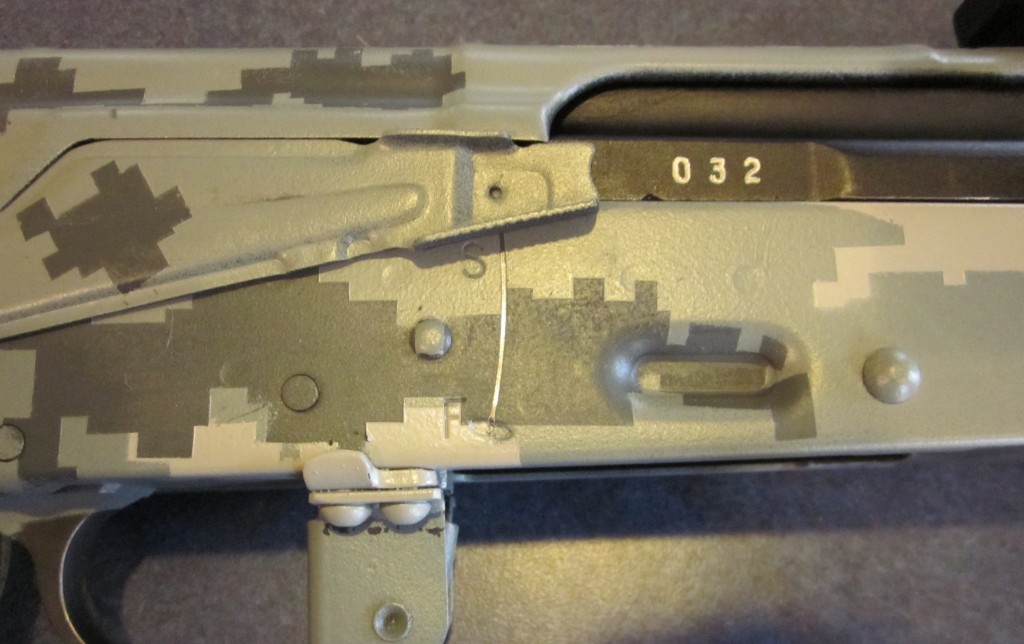 Despite its durability, it already proves to be no match for the AK’s surface-trashing safety lever. In all fairness, I’ve never seen an AK that didn’t sport a shiny arc of bare metal where the chisel-like safety detent scrapes through bluing, parkerizing, and steel itself.
Despite its durability, it already proves to be no match for the AK’s surface-trashing safety lever. In all fairness, I’ve never seen an AK that didn’t sport a shiny arc of bare metal where the chisel-like safety detent scrapes through bluing, parkerizing, and steel itself.
Although not fully cured, my Duracoat is already completely impervious to fingernails, minor dings and common solvents. After letting the Duracoat dry for several days, I used Hoppe’s #9 to remove adhesive residue from the stencils. It was some gooey, sticky stuff; I had to really scrub at it with a solvent-soaked shop rag to get it off. The gunk finally surrendered, but the Duracoat never struck its colors or ran; it didn’t even stain the rag greenish-gray as I’d expected.
A full test of Duracoat’s durability is going to take a bit more time, and I plan to follow up with another review later this year after I can mistreat my pimped-out AK a bit.
Summary
Duracoat seems to be a tough and affordable gun finish, with an application process that’s easily within the skills and tools of the average home hobbyist. Its not just for Bubbas, either: It’s my gunsmith’s go-to finish when he’s asked to fix up a gun with hopeless surface corrosion without spending dozens of hours resurfacing, polishing and hot-bluing.
The results are so durable and attractive that Duracoating has become its own niche industry. A professional shop will disassemble your rifle, detail-strip it and degrease it like you wouldn’t believe, and apply even the most intricate camo patterns for about $250 plus shipping.
This EasyWay kit lets you try this for yourself, at home, for $100. The basic application is simple but laborious, and the devil is in the details. Surface preparation is crucial for a good bonded finish, and a pleasing camo pattern requires at least some visual talent.
I undertook a fairly simple project, using a cheap gun as a testbed, and I’m very pleased with my results. I’m glad I didn’t try for a tigerstripe or DPM pattern, and I sure as hell wouldn’t have used a Noveske (or even a Rock River) AR for my first attempt.
After about sixteen hours of effort, I’m happy with the results, and if I can do it, anybody can.
RATINGS (Out Of Five)
Value: *****
This kit gives you everything you need (except time and elbow grease) to trick out one rifle and one pistol, at the very minimum. If you skimped on the stenciling, you could probably give four rifles a nice thick Duracoating, but you didn’t hear it from me.
Ease of Application (Duracoat): ****
Mix, spray, stencil, mask, repeat. Don’t forget to clear out the sprayer if you’re going to let it sit for more than half an hour.
Ease of Preparation (Duracoat): **
Detail disassembly, degreasing and surface preparation aren’t terribly difficult, but they are very labor-intensive. Don’t be tempted to cut corners.
Ease of Application (Camouflage Pattern): **1/2
Complex curved surfaces are difficult to stencil, and it helps if you apply the colors in the proper order. The kit makes it much simpler, but artistic talent is very helpful, even though ACU is a fairly simple camo pattern.
Overall: ****
A practical and affordable way to customize and protect both your range toys and knockabout guns. If you’re tricking out a top-end gun, you should probably have a professional do it instead.
Durability: To be continued…
This is a marathon, not a sprint. Stay tuned.

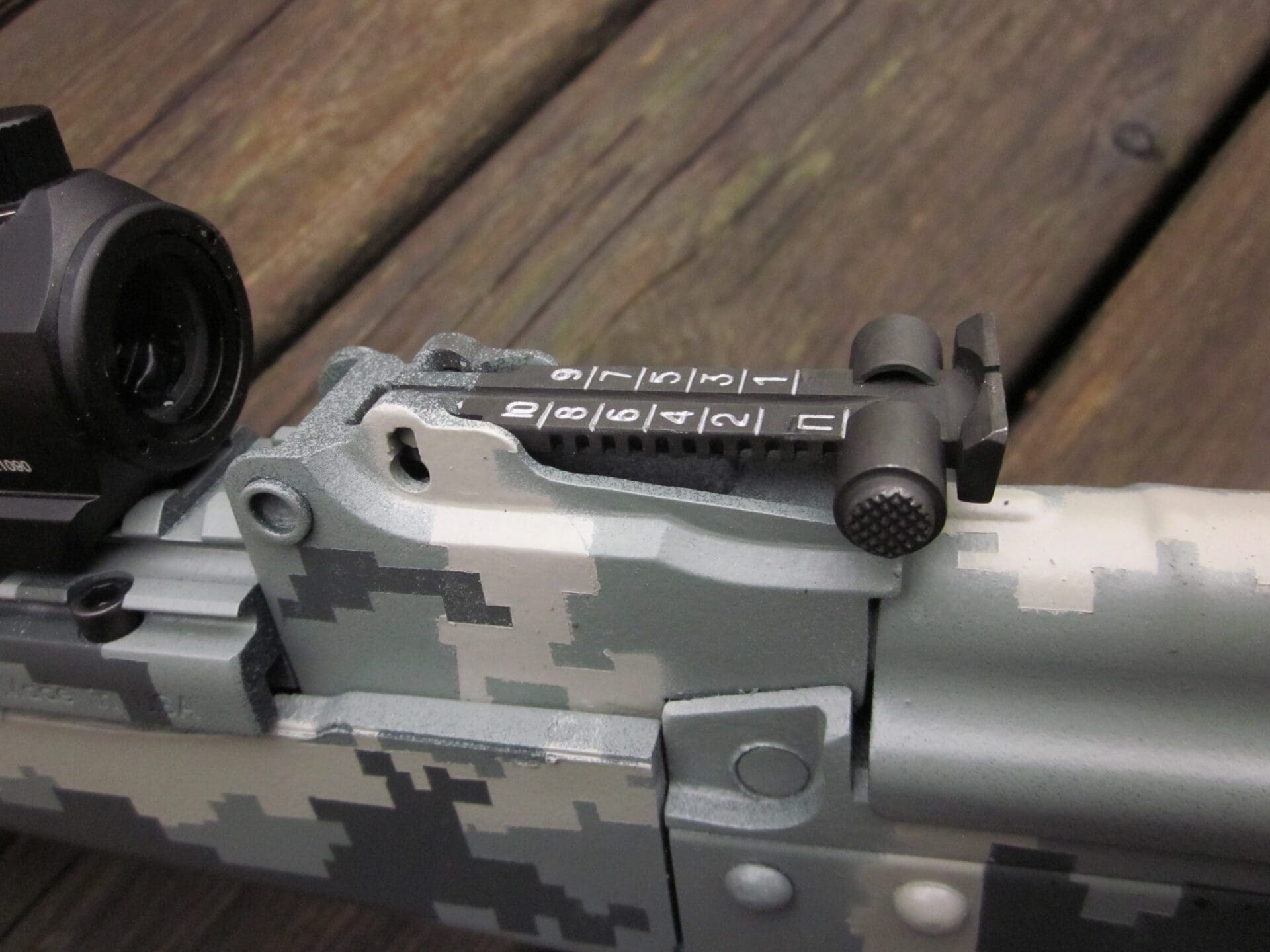



Thanks for jumping in a doing this!
Don’t try this at home boys and girls. I am, after all, a trained professional.
🙂
Sure you can. Get ’em hot and put them on with a small squeegee. You can also shrink them around complex bends with a small pencil torch. It takes some getting used to, but working with adhesive vinyl is no great magic.
A torch? It’s probably best that I didn’t attempt *that* particular technique my first time out (visions of my rifle barbecued, or my garage on fire) but I wish I’d known of the hot stencil and squeegee trick.
a heat-gun (not a torch, but an electric heat-gun) is also helpful for vinyl, stencils, and car tint.
This; I’ve been working in the sign business for the last few years, and I can firmly say that propane torches aren’t the right tool.
Generally speaking you usually only need heat when removing years-old vinyl from old sign panels. The heat causes them to become more elastic, and generally causes the adhesive to stick to the vinyl better (so that it comes off without gumming up the surface much). An electric heatgun is better than a torch because it gives you more precise control of the temperature, and allows you to apply it to a wider area over a long period of time. As a side bonus, since it is most necessary during the winter is that your hands stay nice and toasty while you work.
That said, the same principle also works in reverse; heating it will cause it to bend/fold more easily, and once it cools it should then bond more readily to complex shapes.
A heat gun works fine on relatively large pieces. A propane torch works slightly better as the heat is much more focused in a particular area. In this particular case, the vinyl pieces are too small to direct heat at specific areas with a heat gun (even with a needle attachment). Quick wicks across a specific problem area with a small pencil torch works wonders.
I’ve wrapped several cars completely in vinyl using the propane torch method– it is much faster and yields much better results than a heat gun. Heat guns are extremely useful for removal, though.
Excellent article, though I’d like to offer two points if I may:
1) “careful preparation is the key to a good Duracoat application” This cannot be stressed enough.
2) I strongly recommend powderless latex gloves or the like. Oils from your skin can prevent Duracoat from properly bonding to the metal. Besides, it is dang near impossible to paint anything without getting your hands too.
One kit will easily handle two paintball markers (paintball guns), both my markers I personally duracoated over a year ago and have beat to hell throughout my course of play. The coat, if you let it cure properly before use will stand up to almost anything, including a long fall down a flight of crumbling concrete steps with exposed rebar. I plan on Duracoating my RobinsonXCR’s upper when it arrives.
One of the videos shows me wearing gloves, but I didn’t mention them in the text. I wore them every time I touched the project gun, up until it was time to pull off the stencils and painter’s tape. I always puff some cornstarch on my hands when I use the gloves, since it helps them slip on and off much more comfortably.
Try a multicam pattern next time, I think that looks better on guns.
Multicam is a beast to do properly. Getting the colors to meld together is an art all in its own.
Tigerstripe is the easiest to do I’ve found (tear painters tape on both sides for the stensil), followed by digi, followed by British DPM and other blotchy camos, with Multicam being the hardest.
After reading your article, it seems to me that the $300 or $400 it takes to get a pro to duracoat a gun is well worth it. Sixteen hours of time does not seem worth saving $200-$300 bucks. That’s 19 bucks an hour.
The reason the shops do it so cheaply is that they have tools that allow them to do the time intensive prep much more quickly than you or I can manage in our garages.
I have a couple optics I’m going to be turning black this coming week with Duracoat. We have a parts cleaner at work which is excellent for degreasing, but don’t want to subject electronics to it so will be doing it by hand…
I was wondering, did the tape keep 100% of the paint off? I’m figuring out how I’m going to do this, and I’m hoping some blue painter’s masking tape around the ring of the optic and being careful will be enough to not ruin anything.
Thanks for sharing your experience.
Blue painter’s tape got the job done for me. if you want a really precise edge around the bell of the scope, you might use electrical tape instead. Don’t Duracoat the threads of the turret caps or they’ll never go on again.
I was going to dress up just the stock of a cheap shotty just because I wanted an interesting project to do. Guess what — the price of the Duracoat kit is close to what I paid for the gun. I also looked into the kits on ezdipkits.com, and guess what — they’re the same price as the Duracoat kits. Then I got curious and checked out replacement camo stocks, and guess what — they’re cheaper than either the Duracoat or EZDipkits products.
Since I wanted a project to do, I’m not going to get a new stock — but if someone wanted a camo stock, wouldn’t just buying one be the way to go?
Yes, thanks for this. I learned more than a few things.
wow very nice..
“because few odors will disrupt your domestic tranquility (or persuade you never to cook at home again) faster than the industrial aroma of hot metal bluing in your kitchen oven.”
just send to spinesales:
http://www.youtube.com/user/spinesales?ob=video-mustangbase#p/u/0/iCGzAWLKMf0
All that work and all you have to show for it is a gray gun with Leggo stencils
better luck next time
Go to an auto paint supply house, or plumbing/electrical supply store and they have rubber plugs in various sizes. These are cheap, reusable and perfect for plugging a simple screw hole up to the ends of your optics. Definately a lot more user friendly that wrapping blue tape around an inside curve or against a glass lense.
That really looks awesome. I would love for my SKS to look that good. You should be really happy with being able to do that. I can tell – just from the fact that I skimmed your article – that I dont have the wear-with-all to do it myself and that makes me all the more impressed. Now, how much would you pay to have that done professionally instead of doing it again yourself?
Comments are closed.